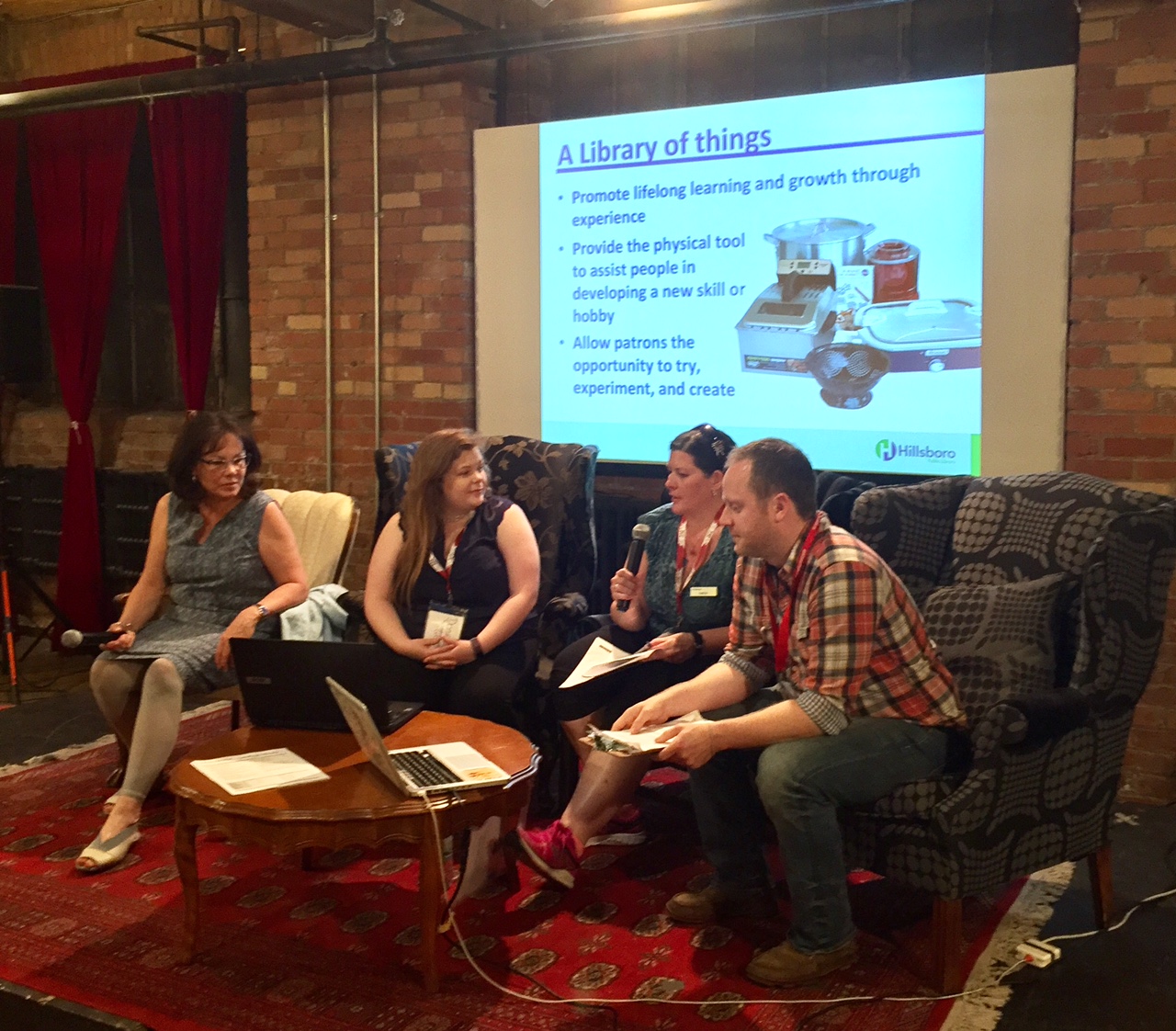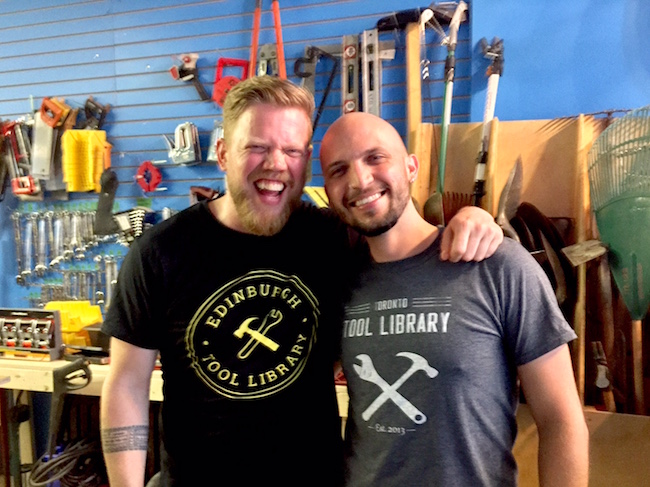Imagine a world where you have low-cost access to common, infrequently used products needed for business or pleasure — tools, toys, musical instruments, camping gear… the list is infinite. Imagine an economy that prioritizes sharing high-quality durable goods, wasting less, and encouraging cooperation. Imagine a close-knit community co-creating a sustainable future. That's the world that the pioneers at the Second Annual International Lending Library Symposium are creating.
This month, the Toronto Tool Library and Sharing Depot, with support from the City of Toronto’s Solid Waste Management Services, hosted a conference at Toronto's Center for Social Innovation where inspiration, passion, and vision were on display. The symposium facilitated a robust exchange of ideas through keynote speakers and multiple workshops. Key topics included: how to start a tool library, makerspaces, variations on libraries of things, volunteer and staff management, the art of repair, collecting and using data, greenhouse gas reporting, social media and communication, accounting, fundraising, and software systems that make sharing easier.
Only five years ago, there were fewer than a dozen active Libraries of Things (LoT) and Tool Libraries around the world. Today, there are more than 150. The LoT movement has continued to gain steam — and after spending three days with these smart, warm visionaries, I can see why. I left wanting to start my own LoT so I could be part of this incredible group of people — and part of the solution to some of the most urgent problems facing our global community.
These thought leaders are co-creating solutions for access to resources, economic development, sustainability, vital community development, and more. Canada, Mexico, Germany, Scotland, and the U.S. all had representatives ranging from veteran LoT librarians to aspiring newbies. While most organizations were focused on tool libraries — toy libraries, kitchen libraries, music libraries, seed libraries, and full-range LoTs all came together to exchange ideas and best practices.

Participants at the Second Annual International Lending Library Symposium. Photo by Cate Homicki/Shareable
First, let me say a bit more about the host, the Toronto Tool Library and Sharing Depot. In just five years, the organization has evolved from a single location tool lending library to four locations that include a maker space, replete with 3D printers, an abundant LoT, and a robust youth program. The group's youth program alone includes after school programs, summer camps, and STEAM education. It has 4,000 members and has provided more than 50,000 loans to-date.
LoTs build community capital and run on it. The Toronto program has inspired 70 volunteers, and last year's symposium host, Station North in Baltimore, Maryland, has 40 volunteers who dedicate their free time to the mission. Toronto's Center for Social Innovation (CSI) turned its social capital into financial capital. Working closely with community and advisors, CSI raised $2.5 million for its building through a community bond, supported by a loan guarantee from the City of Toronto. Today, CSI's community hub represents more than 2,000 organizations focused on growing the new economy.
1. Starting a Library of Things or Tool Library
The first question to ask if you endeavor to begin your own community LoT is — why? And there are many answers to that question. You may be aiming to provide affordable access to things for low-to-moderate income communities. You may aim to provide homecare resources, entrepreneurial resources, and STEAM education to your community. You may aim to reduce consumption, waste, and greenhouse gases. There are many legitimate reasons to start a LoT. After articulating your mission, you need to identify your stakeholders, develop an organizational structure, and find an appropriate space for your LoT. Do you want to be independent, or a program of an existing library or nonprofit? Is your LoT a charity, a cooperative, or a for-profit entity? How will you develop a sustainable funding model? Who shares the skills to bring your vision to life? Where can you set up your LoT so that is accessible and visible? And finally, how can you create a positive retail experience that helps to build community?
It's helpful to talk to LoT veterans to learn tips and tricks to actualize your vision… so if you are an aspiring LoTs librarian, start making plans to attend next year's Third Annual International Lending Library Symposium (location still TBD).
2. Makerspaces
Makerspaces are popular spinoffs of tool libraries. Kevin Morgan from the Toronto Tool Library's makerspace presented a scope of tools and membership models that help these community spaces thrive. While safety and training are key aspects to consider, so are online venues for asking questions, sharing news, and making connections to others. Some of the biggest challenges makerspaces have had to overcome include: finding affordable space, training, standardization of practices, equipment maintenance, and creating a welcoming experience. A creative solution to storage problems is to give members a shoebox for their on-site storage, and charge them for any excess storage space.
3. Volunteer Retention
Volunteer retention and management had its own session, and was a common thread weaving through many workshops. You can often find qualified volunteers through like-minded organizations, social media, farmers' markets, and local colleges. The challenges come with onboarding, scheduling, and retaining skilled and enthusiastic volunteers. Free Google products help with scheduling and management. Many LoTs offer free or deeply discounted memberships as a perk. LoTs with some years under their belts have a clear on-boarding process and clear rules and procedures. They also connect volunteers to the mission and offer social gatherings as perks. Volunteers that feel recognized and valued for the contributions are more likely to commit year after year.
4. Repair
Repair is critical not only to the success of your LoT, but also for nurturing an alternative to our throwaway culture. Many tool libraries offer "repair cafés" where fixers and visitors come together to repair durable goods, jewelry, clothes, bikes, and other things. Paul Magder from Toronto's Repair Café has helped fix 2,000 items over the last four years, representing about 70 percent of the items brought in. An apprenticeship program helps build the culture of repair and reuse. If you endeavor to offer a repair café, have patience. They typically begin with low attendance that snowballs over time. Great venues include schools, libraries, farmers’ markets, community centers, faith institutions, pop-ups, and storefronts.
5. Data: Measure Twice
The symposium held important sessions on data. Now that there are more than 150 LoTs that have facilitated hundreds of thousands of sharing transactions, how do we use that information to inform best practices and demonstrate impact? Najine Ameli (Germany), Devon Fernandes (Canada), Brandon Kidd (Canada), Chris Hellawell (Scotland), and Gene Homicki (U.S.) all helped to share insight into these issues.
Through interviews and surveys, Ameli and Fernandes have found that people are motivated to use LoTs for personal reasons. People say it connects them to their communities and the models are friendlier and build a sense of community compared to conventional tool rental companies. The financial incentive of affordable access was less important to most LoT members than the human element. Interestingly, while LoT provide huge conservation and sustainability impacts, those were the least cited reasons that people chose to become members. These are important considerations when developing pricing structures and marketing materials to build membership.
Still, data on the conservation benefits, greenhouse gas (GHG) reductions, and sustainability impacts of a LoT can be quite valuable, especially when it comes to securing funding. If a LoT wants to secure government or private foundation grants, statistics on the environmental benefits coupled with the community benefits will make a grant application far more compelling. Chris Hellawell from the Edinburgh Tool Library (ETL) is at the helm of LoT GHG reporting, working with Zero Waste Scotland to quantify the climate benefits of reuse. Tracking just cordless drills, last year ETL avoided 2.4 tons of GHG emissions. Chris is developing a spreadsheet to help other libraries calculate their annual GHG emissions reductions.
6. Be Social (Media)
Savvy social media can really elevate a LoT's mission and impact. Good social media not only builds community, it can also raise your library’s membership and visibility to potential funders, such as local government agencies and private foundations. It can also take a lot of time, so it’s worthwhile to try to attain a grant to pay a social media manager. Some key takeaways from Emily Charles Donelson, from the Toronto Tool Library, were to: keep it authentic, encourage dialogue, highlight people’s stories, attach your message to a bigger movement like zero waste or DIY, and treat your audience like an audience — not a market. Other good ideas included creating a hashtag to collect stories from users, and hosting a contest to gather reviews and recommendations on your Facebook page.
7. Fun with Fundraising
Often, when we think of fundraising, we think of awkwardly begging for money from some otherwise reluctant donor that needs to be wooed. Attendees of the fundraising workshop left with a new understanding. Fundraisers are empowering donors to make the change they want to see in the world and feel happier. While that seemed to be the key takeaway from the session, a few other tips resonated. One was that it's typically far easier for a LoT to raise money from local government agencies and community-based foundations than larger private foundations. Another was that tool, toy, and musical instrument manufacturers are often happy to donate free durable goods to your project — so don't feel shy about asking.
8. One Platform to Bind Them (and Manage Them All)
Finally, we heard from the software team at myTurn.com (one of Shareable’s sponsors) that serves a majority of LoTs around the world. Their ever-evolving platform helps LoTs efficiently track and manage their inventories, members, and lets members set up reservations and get reminders to make sure equipment is returned on-time. Now that they have hundreds of locations on their platform, and hundreds of thousands of transactions, there are opportunities for LoTs to attain anonymous reports about usage to better-inform library operations. If you are running a LoT using myTurn.com, the organization’s staff encourage feedback on their platform — so send them your questions and recommendations so the team can continue to optimize the software to make everyone’s experience better.
My final takeaway from the Second Annual International Lending Library Symposium is that this is a global movement with the potential to have huge impact. LoTs help knit together diverse communities. They impart skills and knowledge. They impart values of tolerance, reuse, and sustainability. May these LoTs continue to mushroom around the world and help us achieve the cooperative sustainable future the world demands.
All photos courtesy of Cate Homicki









